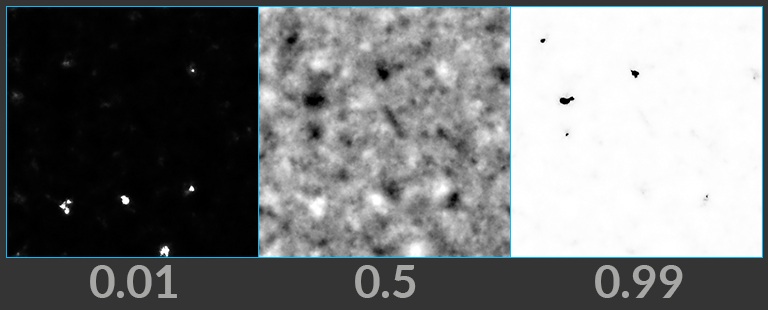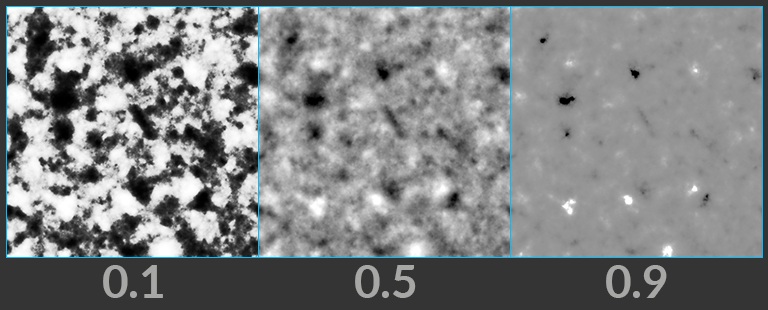| On this page |
This node generates a noise pattern using a fractal approach. The same underlying noise is sampled at increasing frequencies and mixed together. Use the Fractal Noise 3D COP if you want the source location to be the pixel’s world coordinates instead of its image coordinates.
For example, use this node to create cloudy, smoky, or TV static patterns.
Parameters ¶
Signature
The layer type that the source accepts.
See Signatures for more information.
Range ¶
Amplitude
The amount by which to multiply the noise, which the node applies before the Center adjustment.
For example, a value of 0.5 makes a pixel value of 0.5 become 0.25.
Note
Layers can store negative numbers and values above 1, so this may result in out-of-bounds values. Use the Post Processing options to clamp the output.
Center
The center of the output noise range, which offsets the pixel values.
For example, a value of 0.5 makes a pixel value of 0.5 become 1.
Noise Contrast
The amount of contrast to apply to the noise before the Amplitude and Center parameters. You can use this parameter to make the noise more extreme without exceeding the 0 to 1 range.
Pattern ¶
Noise Type
The underlying noise function that’s iteratively sampled to generate the fractal noise.
Torus
Create 4D simplex noise evaluated on a flat torus. This generates noise that’s periodic by construction, which means it doesn’t clamp or round settings to enforce periodic behavior (unlike other noise types).
Perlin
Create Perlin noise on a regular grid. This type of noise generates more natural results.
Worley Cellular F1
Create Worley noise using its primary distance value, which is the distance to the closest worley point. This generates a cell-like noise.
Worley Cellular F2-F1
Create Worley noise using the difference between its second closest and closest points. This generates a cell border-like noise.
White (Random)
Create white noise where each noise element is given a constant but random value.
Alligator
Create alligator noise to produce a bumpy output. This pattern resembles alligator skin.
Per Component
Computes a separate noise for each channel of the output. If off, the output is grayscale for mono and non-mono layers.
Metric
When Noise Type is Worley Cellular F1 or Worley Cellular F2-F1, this is how to define different metrics for computing the distance to a point.
Euclidean
Use the length of the line segment between the two axial points to define the distance between the two points. This can result in circular shapes. See Euclidean distance for more information.
Manhattan
Use the sum of the differences between the two axial points to define the distance between the two points. This can result in diamond shapes. See Taxicab geometry for more information.
Chebyshev
Use the maximum difference between the two axial points to define the distance between the two points. This can result in square shapes. See Chebyshev distance for more information.
Jitter
When Noise Type is Worley Cellular F1 or Worley Cellular F2-F1, this is the amount of random noise to add to each point’s position on a grid. The random noise is added before the Worley noise measures the distance to the points.
Note
Values greater than 1 may produce artifacts because they jitter past the search radius.
Element Size
The size (in image coordinates) of the basic element of the noise. You can turn on the Per-Component Controls button to adjust this further using the Element Scale parameter.
Element Scale
When the Per-Component Controls button is on, this is the per-axis scaling of the element size for anistropic noise.
Offset
The amount to offset the entire noise function in image coordinates.
Tile Size
The size of a single tile of noise. The noise periodically repeats in this size. The size is in image coordinates, so the default is for the entire default canoncial image. If you have a non-square image, this should match the aspect ratio.
Note
If on, values for parameters like Element Size and Lacunarity are rounded or clamped to make them valid. This is because these types of parameters must meet certain conditions for the noise to be tileable.
3D Noise ¶
3D Noise
Evaluates the noise in a 3D space. Use these parameters to control the third dimension, while the first two dimensions are the location in the image.
Animate
Implicitly adds time to the third coordinate.
Pulse Length
The interval length (in seconds) of the noise’s pulse in the third dimension. Lower values increase the rate at which the noise switches its appearance, while higher values decrease this rate.
Time Offset
The amount of time (in seconds) that’s added to the start frame.
Time Scale
The amount of time (in seconds) by which to multiply the start frame. Higher values increase the rate at which the noise switches its appearance, while lower values decrease this rate.
Loop Length (sec)
This is the time (in seconds) at which to repeat the noise. This clamps other options to enforce periodic behavior. Turn this on to generate animations that seamlessly loop.
When off, the animation generally doesn’t repeat after any amount of time.
Fractal ¶
Max Octaves
The amount of times to scale add together the noise.
Lacunarity
The amount to scale the noise for each iteration, which is rounded to an integer value for periodic noise.
Roughness
The amount to scale the amplitude of each successive noise.
Post Processing ¶
Note
The node applies the post-processing operations in the order they're listed.
Fold
Sets the noise values to the absolute value. For example, a pixel value of -2 becomes 2.
Note
This parameter doesn’t impact the output when there’s only positive values.
Complement
Sets the pixel value x to 1 - x.
Note
This method works for values in the 0 to 1 range. For images outside of this range, using Complement results in negative or out of range values.
Bias
The amount to pull the medium grey values (around 0.5) towards zero (if Bias is less than 1) or one (if Bias is greater than 1). A bias value of 0.5 doesn’t affect the values.

Gain
The amount to pull the medium grey values (around 0.5) together, while values around 0 and 1 are pulled apart. A gain value of 0.5 doesn’t affect the noise values.

Gamma
The overall gamma of the generated noise. Values greater than 1 increase the range of values in originally bright areas, which darkens the noise. Values less than 1 stretch out the range of values for originally dark areas, which increases the overall brightness of the noise.
Contrast
The amount to expand or shrink the overall range of tonal values. Each noise value is pushed towards (if Contrast is less than 1) or away from (if Contrast is greater than 1) medium grey values (around 0.5).
Note
This is not the same as Noise Contrast, which appears in some noise nodes and applies contrast during the noise function.
Clamp Minimum
Clamps values below the specified threshold.
Clamp Maximum
Clamps values exceeding the specified threshold.
Inputs ¶
size_ref
A representative layer that determines the size of the output image and controls the metadata.
pos
An optional UV layer with a value that’s used instead of the pixel’s image coordinates for the noise.
time
Each pixel uses this layer’s value for the time.
octaves
An optional octave amount that’s multiplied by the Max Octaves parameter.
roughness
An optional roughness amount that’s multiplied by the Roughness parameter.
Outputs ¶
noise
The computed noise.
| See also |